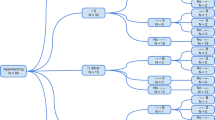Summary
Sexually mature male specimens of Onychogomphus forcipatus perch on stones along the shoreline of rivulets waiting for mates. They react aggressively towards conspecific males. From time to time they fly around, mostly fighting other males. At uniform shorelines they often do not return to perch on the same site, but apparently choose perches at random. This is confirmed by a statistical analysis of the distribution of perching sites along the shoreline. It is concluded that males of O. forcipatus do not defend distinct territories but are aggressive without site attachment. This type of behaviour is considered as phylogenetically primitive in dragonflies.
Zusammenfassung
Die paarungsbereiten Männchen der Libelle Onychogomphus forcipatus sitzen auf Steinen am Ufer von Bächen, wo sie Weibchen erwarten. Gegen männliche Artgenossen sind sie aggressiv. Von Zeit zu Zeit fliegen sie auf, meistens, um mit anderen Männchen zu kämpfen. Danach kehren sie oft nicht zum bisherigen Sitzplatz zurück, sondern setzen sich-besondern an einförmigen Ufern — an eine offensichtlich zufällig gewählte Stelle. Eine statistische Analyse ergab eine zufällige Verteilung der Sitzplätze entlang der Uferlinie. Die Männchen dieser Libellenart grenzen also keine Territorien ab, sondern sind aggressiv, ohne gleichzeitig ortsgebunden zu sein. Dieses Verhalten ist als phylogenetisch ursprünglich bei Großlibellen anzusehen.
Similar content being viewed by others
Literatur
Corbet, P. S.: A biology of dragonflies. London: Witherby 1962
Fraser, F. C.: A reclassification of the order Odonata. Roy. Zool. Soc.N. S. Wales 12, 1–133 (1957)
Furtado, J. I.: Ecology of Malaysian odonates: Biotope and association of species. Verh. internat. Verein. Limnol. 17, 863–887 (1969)
Hennig, W.: Phylogenetic systematics. Ann. Rev. Entom. 10, 97–116 (1965)
Heymer, A.: Fortpflanzungsverhalten und Territorialität bei Orthetrum coerulescens (Fabr., 1798) und O. brunneum (Fonsc., 1837) (Odonata; Anisoptera). Rev. Comp. Animal 3, 1–24 (1969)
Ito, Y.: Territorialism and residentiality in a dragonfly, Orthetrum albistylum speciosum Uhler (Odonata: Anisoptera). Ann. Entom. Soc. Amer. 53, 851–853 (1960)
Jacobs, M. E.: Studies on territorialism and sexual selection in dragonflies. Ecology 36, 566–586 (1955)
Kaiser, H.: “Zeitliches Territorialverhalten” bei der Libelle Aeschna cyanea. Naturwissenschaften 55, 657 (1968)
Kaiser, H.: Regulation der Individuendichte am Paarungsplatz bei der Libelle Aeschna cyanea durch “zeitliches Territorialverhalten”. Zool. Anz., Suppl.-Bd. 33, Verh. Zool. Ges. 1969., 79–85 (1970)
Kaiser, H.: Die Regelung der Individuendichte bei Libellenmännchen (Aeschna cyanea, Odonata). Eine Analyse mit systemtheoretischem Ansatz. Oecologia (Berl.) 14, 53–74 (1974a)
Kaiser, H.: Die tägliche Dauer der Paarungsbereitschaft in Abhängigkeit von der Populationsdichte bei den Männchen der Libelle Aeschna cyanea (Odonata). Oecologia (Berl.) 14, 375–387 (1974b)
Kaiser, H.: Verhaltensgefüge und Temporialverhalten der Libelle Aeschna cyanea (Odonata). Z. Tierpsychol. (im Druck)
Kirmse, W., Lässig, P.: Strukturanalogie zwischen dem System der horizontalen Blickbewegungen der Augen beim Menschen und dem System der Blickbewegungen des Kopfes bei Insekten mit Fixationsreaktionen. Biol. Zbl. 90, 175–193 (1971)
Klötzli, A. M.: Zur Revierstetigkeit von Calopteryx virgo (L.). Mitt. schweiz. entom. Ges. 43, 240–248 (1971)
Mayer, G.: Studien an der Heidelibelle Sympetrum vulgatum (L.). Naturk.Jb. der Stadt Linz, 201–217 (1961)
Pajunen, V. I.: Studies on the population ecology of Leucorrhinia dubia v. d. Lind. (Odon., Libellulidae). Ann. Zool. Soc. “Vanamo” 24, 1–79 (1962a)
Pajunen, V. I.: A description of aggressive behaviour between males of Leucorrhinia dubia v. d. Lind. (Odon., Libellulidae). Ann. Ent. Fenn. 28, 108–118 (1962b)
Pajunen, V. I.: The influence of population density on the territorial behaviour of Leucorrhinia rubicunda L. (Odon., Libellulidae). Ann. Zool. Fenn. 3, 40–52 (1966a)
Pajunen, V. I.: Aggressive behaviour and territoriality in a population of Calopteryx virgo L. (Odon., Calopterygidae). Ann. Zool. Fenn. 3, 201–214 (1966b)
Robert, P. A.: Die Libellen (Odonaten). Bern: Kümmerly und Frey 1959
Schiemenz, H.: Die Libellen unserer Heimat. Stuttgart: Franckhsche Verlagsbuchhandlung 1957
Schmidt, Er.: Odonata. In: P. Brohmer, P. Ehrmann, G. Ulmer, Eds., Die Tierwelt Mitteleuropas, Bd. 4. Leipzig: Quelle und Meyer 1929
Tinbergen, N.: The functions of territory. Bird Study 4, 14–27 (1957)
Zahner, R.: Über die Bindung der mitteleuropäischen Calopteryx-Arten (Odonata, Zygoptera) an den Lebensraum des strömenden Wassers. II. Der Anteil der Imagines an der Biotopbindung. Int. Revue ges. Hydrobiol. 45, 101–123 (1960)
Author information
Authors and Affiliations
Additional information
Mit Unterstützung durch die Deutsche Forschungsgemeinschaft.
Rights and permissions
About this article
Cite this article
Kaiser, H. Intraspezifische Aggression und räumliche Verteilung bei der Libelle Onychogomphus forcipatus (Odonata). Oecologia 15, 223–234 (1974). https://doi.org/10.1007/BF00345179
Received:
Issue Date:
DOI: https://doi.org/10.1007/BF00345179




